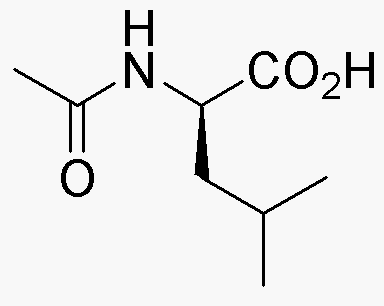Acetyl-D-leucine is widely utilized in research focused on:
- Neurological Research: This compound is studied for its potential neuroprotective effects, particularly in conditions like Alzheimer's disease, where it may help in reducing cognitive decline.
- Pharmaceutical Development: Used as a building block in the synthesis of pharmaceuticals, it aids in the development of drugs targeting metabolic disorders.
- Sports Medicine: Athletes and trainers explore its benefits for muscle recovery and performance enhancement, as it may assist in protein synthesis.
- Biochemical Studies: Researchers utilize it in studies of amino acid metabolism, helping to understand its role in various biochemical pathways.
- Dietary Supplements: It is incorporated into nutritional products aimed at improving muscle mass and overall health, appealing to fitness enthusiasts.
Informations générales
Propriétés
Sécurité et réglementation
Applications
Acetyl-D-leucine is widely utilized in research focused on:
- Neurological Research: This compound is studied for its potential neuroprotective effects, particularly in conditions like Alzheimer's disease, where it may help in reducing cognitive decline.
- Pharmaceutical Development: Used as a building block in the synthesis of pharmaceuticals, it aids in the development of drugs targeting metabolic disorders.
- Sports Medicine: Athletes and trainers explore its benefits for muscle recovery and performance enhancement, as it may assist in protein synthesis.
- Biochemical Studies: Researchers utilize it in studies of amino acid metabolism, helping to understand its role in various biochemical pathways.
- Dietary Supplements: It is incorporated into nutritional products aimed at improving muscle mass and overall health, appealing to fitness enthusiasts.
Documents
Fiches de données de sécurité (FDS)
La FDS fournit des informations de sécurité complètes sur la manipulation, le stockage et l’élimination du produit.
Spécifications du produit (PS)
Le PS fournit une description complète des propriétés du produit, notamment sa composition chimique, son état physique, sa pureté et les exigences de stockage. Il détaille également les plages de qualité acceptables et les applications prévues du produit.
Certificats d'analyse (COA)
Recherchez des certificats d'analyse (COA) en saisissant le numéro de lot du produit. Les numéros de lot et de lot se trouvent sur l'étiquette d'un produit, après les mots « Lot » ou « Lot de fabrication ».
Numéro de catalogue
Numéro de lot/série
Certificats d'origine (COO)
Ce certificat d'exploitation confirme le pays dans lequel le produit a été fabriqué, et détaille également les matériaux et composants utilisés et s'il est issu de sources naturelles, synthétiques ou autres sources spécifiques. Ce certificat peut être requis pour les douanes, le commerce et la conformité réglementaire.
Numéro de catalogue
Numéro de lot/série
Fiches de données de sécurité (FDS)
La FDS fournit des informations de sécurité complètes sur la manipulation, le stockage et l’élimination du produit.
DownloadSpécifications du produit (PS)
Le PS fournit une description complète des propriétés du produit, notamment sa composition chimique, son état physique, sa pureté et les exigences de stockage. Il détaille également les plages de qualité acceptables et les applications prévues du produit.
DownloadCertificats d'analyse (COA)
Recherchez des certificats d'analyse (COA) en saisissant le numéro de lot du produit. Les numéros de lot et de lot se trouvent sur l'étiquette d'un produit, après les mots « Lot » ou « Lot de fabrication ».
Numéro de catalogue
Numéro de lot/série
Certificats d'origine (COO)
Ce certificat d'exploitation confirme le pays dans lequel le produit a été fabriqué, et détaille également les matériaux et composants utilisés et s'il est issu de sources naturelles, synthétiques ou autres sources spécifiques. Ce certificat peut être requis pour les douanes, le commerce et la conformité réglementaire.


